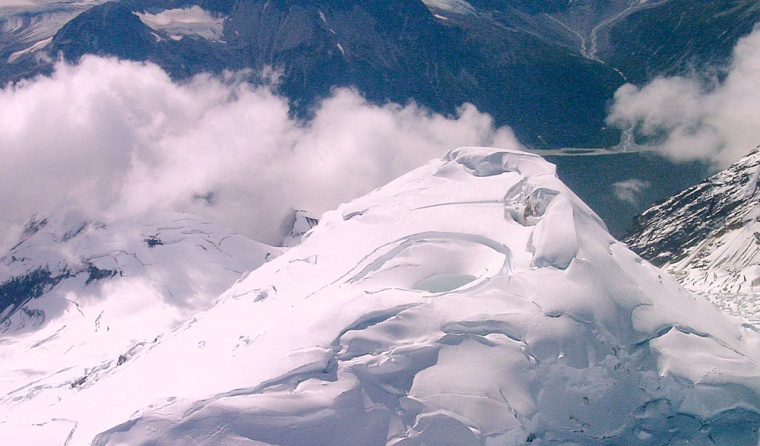The last time Mount Spurr erupted, it spewed a plume 50,000 feet in the air, driving Anchorage residents indoors, shutting down airports and setting ash adrift as far away as Greenland.
Twelve years later, the volcano is again restless. Fifteen to 25 small earthquakes a day have been rumbling beneath Mount Spurr for the past month. Last week, the Alaska Volcano Observatory raised its level of concern from green (dormant) to yellow (restless).
On Tuesday, scientists found a giant hole, 165 feet in diameter and 82 feet deep, in Mount Spurr's ice cap that may have been formed by the heat under the surface of the volcano. Such a hole has not been seen on the mountain in memory, said John Power, a seismologist with the observatory.
But the volcanic activity is different from what preceded the three eruptions in 1992 and scientists say there is no imminent threat of an eruption.
"It is unusual, that is why we raised the color of the level of concern," Power said Wednesday. "The most likely scenario is that this is going to die off with no eruptive activity."
But, he added, the possibility of an eruption cannot be ruled out.
In 1992, earthquake swarms under the 11,100-foot Mount Spurr and nearby Crater Peak led to eruptions in June, August and September of that year. Before then, the volcano had been dormant since 1953.
The eruption in August lasted four hours and was the worst to hit Anchorage, 80 miles to the east across Cook Inlet. The ash cloud drove people with respiratory problems indoors and closed the Anchorage airport for 20 hours. The region's other air fields, Merrill Field, Lake Hood, Elmendorf Air Force Base and Kenai Municipal Airport, also were closed.
Afterward, the rumblings tapered off until Mount Spurr was quiet again in 1997, Power said.
Safety preparations
Nearby state and local agencies have begun preparing for Mount Spurr's reawakening.
The Matanuska-Susitna Borough was shipping 100 air filter masks to the residents of Skwentna, said Dennis Brodigan, director of emergency services for the borough north of Anchorage and northeast of Mount Spurr. The village of 94 is one of the communities closest to the volcano, just 60 miles away.
No roads lead to Skwentna, and emergency crews could have problems reaching the village if the volcano erupted, he said.
"This has happened several times in the past in Skwentna," Brodigan said. "Their biggest concern is shutting down their generators" due to an ash cloud.
The borough also is stocking up on air filters for its vehicles and protective equipment for emergency personnel.
The state Division of Homeland Security and Emergency Management on Wednesday was updating its Web site with information for residents on how to prepare their homes and cars for an ash cloud, said homeland security spokesman Jamie Littrell.
The Federal Aviation Administration has been monitoring updates from the observatory. If an eruption were to again cover Anchorage and close the airports, aircraft could be diverted to Fairbanks, Kenai and King Salmon, according to spokesman Mike Fergus in Renton, Wash.
The biggest threat to Anchorage, Alaska's largest city with a population of about 270,000, would again be the ash.
"I think the worst-case scenario is if the ash cloud traveled directly over Anchorage like it did '92," Littrell said.
Scientists at the observatory are tracking the volcano's activity with 11 seismic sensors, satellite imagery and fly overs.
The observatory's next alert level is orange, meaning an eruption could happen at any time. Power said to raise the level again, Mount Spurr would have to steam and show even more earthquake activity. So far, no smoke from the volcano has been spotted.
Power said residents would be smart to check their emergency equipment, make sure they won't run out of prescription medication and have enough food and water to be on their own for up to two days.
